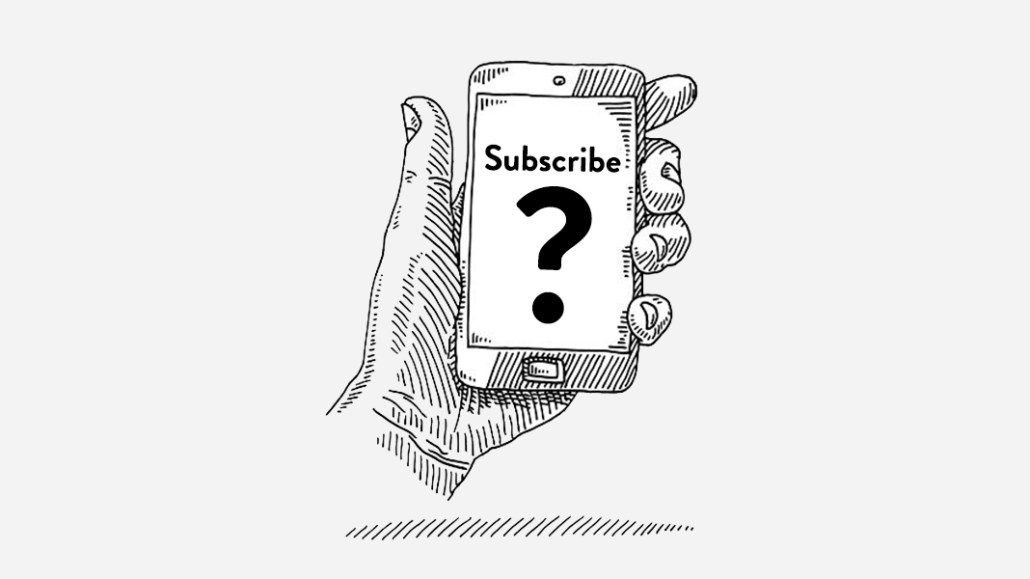Register by Jan 13 to save on passes and connect with marketers from Uber, Bose and more
Why publishers’ e-commerce ambitions are extending to subscriptions

Two weeks ago, Mashable published its first e-commerce post. Instead of promoting a gadget or clothing, this post offered readers a subscription to Disconnect, a VPN and ad-tracking blocker.
Mashable, along with Gizmodo Media Group, Ziff Davis and Purch, have begun publishing e-commerce posts aimed at getting readers to subscribe to services rather than purchase physical goods.
That’s because subscriptions offer higher payouts, and they allow publishers to avoid being overly reliant on Amazon, the main retail partner that publishers pursuing affiliate commerce revenues use. Publishers can also use what they know about readers’ interests to pitch subscription startups that need to acquire new customers.
“[Publishers] are all doing the same thing — they’re trying to figure out how to get their percentage of payment higher,” said Josh Payne, the CEO of StackCommerce, a startup that offers commerce services to over 100 publishers.
Selling subscriptions isn’t new. Gawker Media, now Gizmodo Media Group, offered discounted web-hosting deals to readers of its Kotaku and Lifehacker verticals in 2013. But with a boom in subscription services in fashion, food and tech, the opportunity for publishers to offer these kinds of deals has expanded.
They are also potentially much more lucrative. If a publisher’s e-commerce post leads a reader to buy a pair of jeans on Amazon, the publisher gets a commission of 4 to 8 percent of the retail price. If that same publisher puts up a post about subscribing to Blue Apron, the meal delivery subscription service, the commission for a subscriber could be as much as $80, which is based on a portion of the customer’s expected lifetime value to Blue Apron, Payne said.
Spending $80 once to acquire a customer that might order hundreds, or thousands of dollars worth of product from you over the long haul is good business for Blue Apron; getting $80 for one reader click, rather than $8 or $9 from a jeans purchase, is good business for publishers. “Paying specifically for good customers becomes more and more desirable,” said Andrea Wasserman, an e-commerce consultant.
The spread of this strategy is also being driven, at least partly, by the subscription-based e-commerce startups themselves, which have proliferated as entrepreneurs looked to replicate the success of Birchbox. Investors in these companies have demanded subscriber growth, and the startups have welcomed the help of publishers.
“If you get a company with 100 million readers emailing you, that’s music to their ears,” said Ryan Brown, svp of commerce at Gizmodo Media Group.
Publishers often repost these pieces multiple times because they have the potential to yield substantial returns.
Subscription-based pieces aren’t likely to surpass the affiliate revenue that remains the bread and butter of commerce-focused publishers. But they represent an incremental revenue source for publishers that are struggling to grow digital ad revenue.
“It’s a smaller share [of overall commerce revenue], but we consider it a moat around the affiliate business,” Brown said. “If the reader doesn’t want [the deal], we shut these things down.”
More in Media

Why publishers are building their own creator networks
Publishers are forming creator networks to regain control, combat traffic declines, and reach audiences shifting toward influencers.

The accidental guardian: How Cloudflare’s Matthew Prince became publishing’s unexpected defender
Cloudflare’s day job is fending off botnets and nation-state cyberattacks, not debating how Google and other AI firms crawl publisher sites.

A timeline of the major deals between publishers and AI tech companies in 2025
Here’s a list of all the major deals signed between publishers and AI tech companies in 2025.








